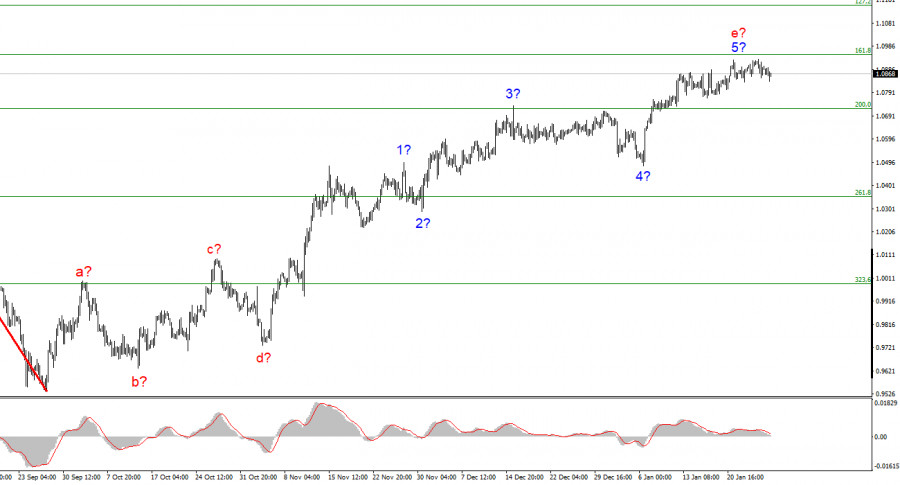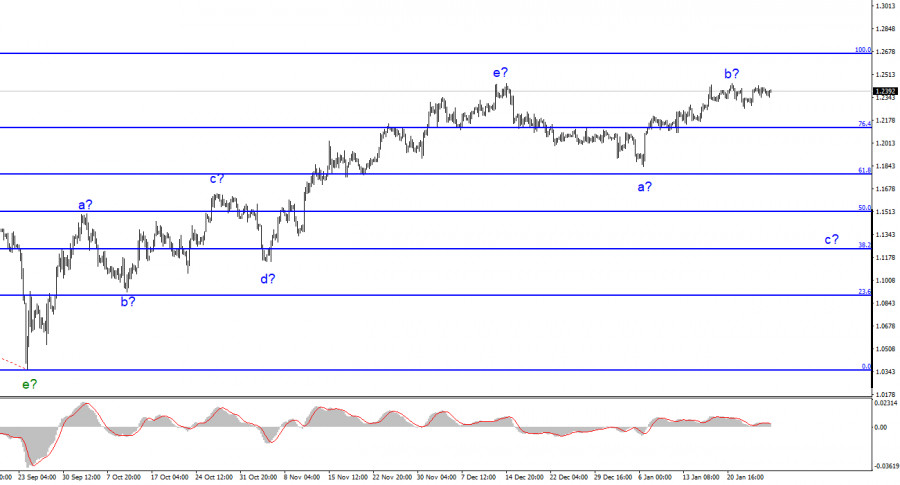
What conclusions can we draw now that another week on the foreign currency market has come to an end? Unfortunately, there aren't many conclusions because this week, particularly in the UK, there wasn't much in the way of news or economic data. The euro and the pound's wave markings are starting to diverge from one another, and the market did not demonstrate a desire to be active. The first difference stands out right away: the European continues to increase more vigorously, which prevents the development of even the slightest downward trend section. In recent weeks, the British pound has "deflated," and there is a greater likelihood that this trend will continue. The second distinction is that for the British pound, the development of a rectification section might already have started, whereas, for the euro, this option is entirely ruled out.
Since the demand for the US dollar essentially stagnated last week, but both wave marks currently point to a decline, we can only hold out hope for the first week of February. There has already been a lot said about this, so what else is there to discuss a few days before the first central bank meetings in 2023? The majority of analysts are currently solely talking about upcoming changes to the currencies of the US, UK, and EU. As a result, from my perspective, there are no ambiguities regarding the ECB and Fed meetings. Only the speeches of Jerome Powell or Christine Lagarde can spark market interest. Although they have performed five times in the previous two weeks. During the forums in Davos and Germany last week and this week, she had the chance to say whatever she wanted. Powell's speech is the only one left that piques my interest now. The US dollar may once again depreciate if Jerome Powell's rhetoric shifts to the left. It is no secret that the Fed is gradually shifting away from raising interest rates. The tightening will stop after one or two more meetings. Even the February meeting of the Bank of England was shrouded in fog, not to mention all subsequent meetings. There are ongoing disagreements in the market on the magnitude of the rate hike; there is no consensus.

The UK must continue to follow a strict financial plan and the November budget, according to British Finance Minister Jeremy Hunt, to reduce inflation. Does it seem that the Bank of England is no longer interested in lowering consumer prices? Although the British regulator has increased the rate a total of nine times, inflation is still above 10%. While energy costs have decreased globally, inflation in the UK has yet to significantly slow. Andrew Bailey, the governor of the Bank of England, declared that inflation will gradually decline, but I wouldn't take his comments seriously. The UK government also points out that pay growth is growing at high rates, which could lead to a new acceleration in price growth. All of the aforementioned information suggests that to lower inflation, the British people must earn less money and spend less.
I conclude that the upward trend section's building is about finished based on the analysis. As a result, given that the MACD is signaling "down," it is now possible to contemplate sales with goals close to the predicted mark of 1.0350, or 261.8% per Fibonacci. The potential for complicating and extending the upward portion of the trend remains quite strong, as does the likelihood of this happening. The market will be ready to finish the wave e when a bid to break through the 1.0950 level fails.

The construction of a downward trend section is implied by the wave structure of the pound/dollar instrument. Currently, sales with objectives at the level of 1.1508, or 50.0% Fibonacci, might be taken into account. You can set a stop loss order above the peaks of waves e and b. The upward portion of the trend is probably over, however, it might yet take a longer form than it does right now. However, you must exercise caution while making sales because the pound has the propensity to rise.